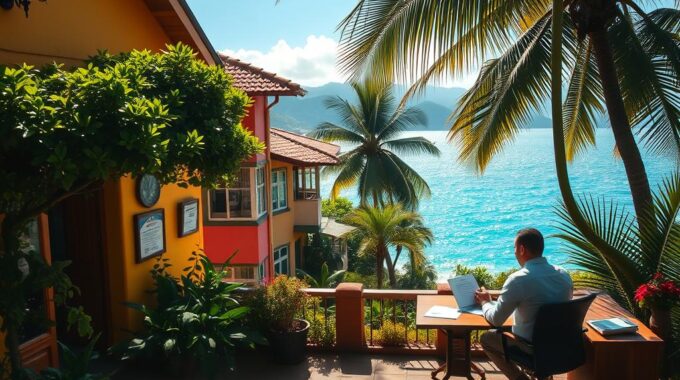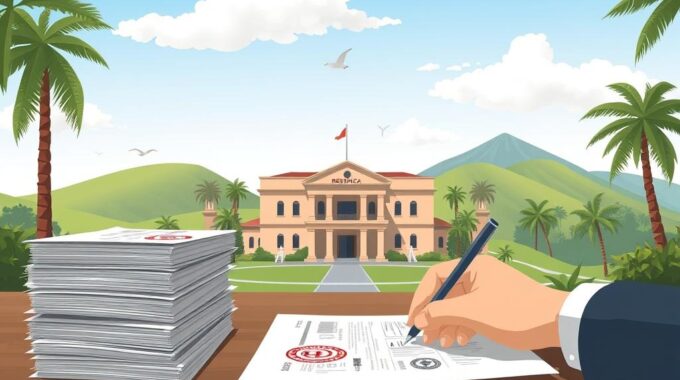Learn about hard money lending for financial freedom Costa Rica. GAP Investments offers tailored financing from $50,000 to $3,000,000.

Costa Rica Residency: Your Guide to Permanent Living with CRIE.
Ever dreamed of waking up to exotic birds and palm trees? Costa Rica could make that dream real. Costa Rica Immigration Experts (CRIE) makes getting residency easy. With over 20 years of experience, CRIE has helped thousands.
There are many ways to get Costa Rica residency. Each has its own benefits and challenges. As you learn about the process, you’ll see it’s more than just moving. It’s a chance to live a life full of joy and simplicity.
Key Takeaways
- CRIE has over 20 years of experience in facilitating residency applications.
- Costa Rica offers various residency options, including Pensionado, Rentista, and Inversionista visas.
- The residency application process may take up to a year to complete.
- Investors under the Inversionista residency must invest a minimum of $200,000.
- Retirees qualifying for the Pensionado program need a monthly pension of at least $1,000.
- Community engagement is strong, with about 39% of Costa Ricans participating in volunteer activities.
- Understanding the residency requirements is crucial for a successful application.
Understanding Residency Options in Costa Rica
Exploring Costa Rica’s residency options can be tricky. It’s key to know the different visas to smoothly relocate. This knowledge helps meet Costa Rica visa requirements.
Types of Residency Visas
Costa Rica has various residency visas for different needs. Each visa has its own perks and rules, fitting different lifestyles:
- Pensionado: For retirees, it needs a minimum monthly pension of $1,000.
- Rentista: Good for those with a stable income of at least $2,500 a month.
- Inversionista: For those investing $200,000 in local businesses or properties.
Pensionado, Rentista, and Inversionista Explained
Each visa offers a unique path through Costa Rica’s immigration. Pensionados get special tax rates and social security. Rentistas enjoy financial flexibility, and inversionistas get big investment chances.
These options suit modern expats, like digital nomads and retirees, who want a good work-life balance.
Short-term vs. Permanent Residency
Starting with short-term residency is good for those wanting to try Costa Rica first. Permanent residency lets you fully enjoy local life, including healthcare and driving licenses. Knowing these differences helps plan your stay and meet visa needs.
The Benefits of Costa Rica Residency
Getting residency in Costa Rica brings many perks that make life better. You get great healthcare and a low cost of living. These benefits draw people looking for a healthier, happier life.
Quality of Life and Healthcare Access
Being a resident in Costa Rica means you get top-notch healthcare. This is a big benefit of Costa Rica residency. The healthcare system is strong, covering both locals and expats. Once you get residency, you get Social Security benefits for medical care.
The climate and nature are also amazing. They add a lot to the quality of life here.
Tax Benefits and Economic Opportunities
Costa Rica permanent residency also offers tax perks. The country taxes only income earned within its borders. This is great for retirees and expats with fixed incomes.
Residents get discounts at tourist spots and national parks. These deals make living in Costa Rica even more appealing.
Integration into the Local Community
Living in Costa Rica means diving into the local culture. You can join local events and feel part of the community. This helps you make friends and feel at home.
According to Costa Rica Immigration and Residency Services, fitting in is key to enjoying ‘Pura Vida’ life.
Getting Costa Rica Residency: The Application Process
The Costa Rica residency application process might seem hard, but knowing each step makes it easier. First, pick the right residency category. This could be Pensionado, Rentista, or Inversionista, depending on your situation and goals.
Step-by-Step Guide to the Application
To understand the Costa Rica residency requirements, follow these steps:
- Start by registering with your home country’s consulate in Costa Rica. This is a must for residency applicants.
- Collect the needed documents. These include:
- Criminal Background Check
- Birth Certificate
- Marriage or Divorce Certificate
- Make sure all documents are apostilled and translated into Spanish by an official translator.
- Get your passport copies notarized by a Costa Rican notary public.
- Put together your residency packet. It should have the application form, a letter to the Director of Migracion, and all your documents.
Necessary Documentation and Processing Times
The time it takes to process residency applications varies. It can be a few weeks or several months. The initial decision might take up to 90 days, depending on your category. Organizing your documents well can help avoid delays.
Applying for temporary residency for retirees needs a monthly pension of over $1,000. You’ll also need to pay $50 to start the process. Each page of your request might cost $1.25 or $2.50. Students, teachers, researchers, and interns face similar fees and requirements when applying for Costa Rica residency.
Sending in all documents on time is key. This includes the Criminal Background Check, which can take almost 15 weeks. This step is crucial for a quick Costa Rica residency application process.
For detailed info on permanent residency, check out the CRIE website. It offers valuable insights and guidance.
Common Challenges in the Residency Application Process
Getting residency in Costa Rica can be tough. Many face problems with documents. It’s key to keep up with Costa Rica immigration updates to tackle these issues.
Document Preparation and Verification Issues
Preparing documents is a big hurdle. You need birth certificates, criminal checks, and proof of income. These must be apostilled and translated into Spanish. Not doing this right can cause delays.
Using an immigration lawyer can help. They can make the process smoother and faster. This shows how important it is to know the challenges of Costa Rica residency.
Understanding Costa Rica’s Immigration Updates
Knowing about immigration policy changes is crucial. There are different residency types, like the Rentista Program. It needs a monthly income of at least $2,500 or a $60,000 deposit.
The application time can vary from 4 to 12 months. Staying updated with policies helps. Getting help from experts like Costa Rica Immigration Experts (CRIE) can be very beneficial.
Conclusion
Getting residency in Costa Rica has many perks, making it a great choice for those wanting to live here. It’s not just about having a place to stay. You also get access to important social services, quality healthcare, and a friendly community. Experts like Costa Rica Immigration Experts (CRIE) can help you through the application process.
Living in Costa Rica as a resident means you can choose between temporary and permanent residency. Moving from temporary to permanent takes about three years. It requires careful planning and timely paperwork. Getting help from professionals is key to avoid delays and ensure everything goes smoothly.
The beauty of Costa Rica is more than just the paperwork. It’s about the vibrant culture, breathtaking landscapes, and the focus on community. If you’re thinking of moving here, take the leap. With CRIE’s help, you’ll have a smooth and rewarding experience in your new home.
Source Links
- https://crie.cr/your-guide-to-residency-in-costa-rica-with-crie-cr/
- https://crie.cr/costa-rica-residency-your-guide-to-pura-vida-living/
- https://cr.usembassy.gov/services/residency/
- https://quatro.legal/expats/
- https://crie.cr/benefits-of-costa-rica-residency/
- https://aglegal.com/inmigration-law/6-new-reasons-to-be-a-resident-in-costa-rica/
- https://quatro.legal/benefits-of-obtaining-a-costa-rican-residency/
- http://www.costarica-embassy.org/index.php?q=node/147
- https://www.twoweeksincostarica.com/applying-residency-costa-rica-without-lawyer/
- https://gap.cr/understanding-costa-rica-residency-challenges-crie-can-help/
- https://www.gaprealestate.com/is-it-hard-to-get-residency-in-costa-rica/
- https://gap.cr/costa-rica-residency-how-long-does-it-take/
- https://crie.cr/navigating-costa-rica-residency-challenges-with-crie/


